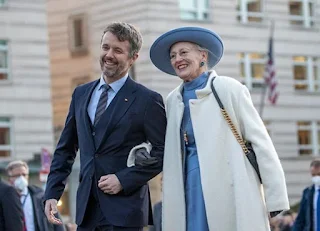Queen Margrethe II of Denmark surprised the public on December 31, 2023, when she announced her plan to step down from the Danish throne on January 14, 2024, the 52nd anniversary of her accession to the throne. The last Danish monarch who abdicated the throne was Eric III called The Lamb in the 12th century. He became a monk afterward.
Queen Margrethe II is the first monarch in Europe in nearly 10 years to abdicate the throne. The last one was her third cousin, King Juan Carlos of Spain on June 19, 2014.
 |
| Emperor Akihito of Japan and Empress Michiko |
 |
| Queen Beatrix and Queen Margrethe II |
 |
| King Juan Carlos I and King Albert II |
There were forced abdications in the past due to political tension such as King Michael I of Romania, Tsar Simeon II of Bulgaria, and King Constantine II of Greece, however in recent decades, monarchs voluntarily abdicated the throne due to old age and health reasons.
 |
| Grand Duke Jean |
Grand Duke Jean of Luxembourg also abdicated the throne just before the close of the 20th century in October 2000 in favor of his eldest son, now Grand Duke Henri. He died in 2019
In the 21st century, there are eight known abdications happened around the world:
1. 2024 January 14: Queen Margrethe II of Denmark
- Date of birth: April 16, 1940
- Date of accession: January 14, 1972
- Age when she became Queen: 32
- Age at abdication: 83
- Length of Reign: 52 years
- Title following abdication: Her Majesty Queen Margrethe
 |
| Crown Prince Frederik and his mother, Queen Margrethe II |
Her Majesty will formally step down from the Danish throne on January 14, 2023, the 52nd anniversary of her enthronement. She ascended the Danish throne in 1972 following the death of her father, King Frederick IX.
She was 32 years old when she became the first Queen regnant in Denmark from the House of Glucksburg. Today, she is 83 years old. She cited her back surgery as a major reason for her decision to abdicate and hand over the monarchy to her eldest son, Crown Prince Frederik.
When King Frederik X begins his reign later this month, his eldest son, Prince Christian, who just turned 18 in October 2023, will be the new Crown Prince of Denmark.
2. 2019 April 30: Emperor Akihito of Japan
- Date of birth: December 23, 1933
- Date of accession: January 7, 1989
- Age when he became emperor: 55
- Age at abdication : 85
- Length of Reign: 30 years
- Title following abdication: Emperor Emeritus
 |
| Emperor Akihito and his son, now Emperor Naruhito |
The abdication of Emperor Akihito of Japan was announced by former Japan's Prime Minister, Shinzo Abe in December 2017. The emperor formally abdicated the throne on April 30, 2019, citing old age and declining health as his reasons.
 |
| Emperor Naruhito of Japan and Empress Masako |
He was succeeded by his eldest son, now Emperor Naruhito. His second son, Prince Fumihito of Akishino is Japan's Crown Prince since the House of Chrysanthemum is restricted to male heirs and Emperor Naruhito has an only child - Princess Aiko.
3. 2014 June 19: King Juan Carlos I of Spain
- Date of birth: January 5, 1938
- Date of accession: November 22, 1975
- Age when he became king: 37
- Age at abdication: 76
- Length of reign: 39 years
- Title following abdication: King Emeritus
 |
| King Juan Carlos and his son, now King Felipe VI |
After a series of controversies in 2012, corruption charges for his youngest daughter and her husband, and his health conditions, King Juan Carlos I of Spain voluntarily abdicated on June 19, 2014.
The greatest legacy of King Juan Carlos's reign was the restoration of democracy in Spain following decades of autocratic rule by Francisco Franco. He enjoyed popularity for the most part of his reign until his controversial elephant hunting that went wrong years before his abdication.
He was succeeded by his only son, now King Felipe VI. The current heir-presumptive (Spain still following the male-preference primogeniture succession) is Leonor, the Princess of Asturias, who just turned 18 in October 2023.
4. 2013 July 21: King Albert II of Belgium
- Date of birth: June 6, 1934
- Date of accession: August 9, 1993
- Age when he became king: 59
- Age at abdication: 79
- Length of reign: 19 (just days before his 20th anniversary)
- Title following abdication: King Emeritus
 |
| King Albert II and his son, now King Philippe |
His Majesty King Albert II of Belgium also cited his failing health condition as the reason for his abdication in 2013. He formally stepped down from the Belgian throne on July 21, 2013, during the country's national day celebration.
He was succeeded by his eldest son, now King Philippe. The succession law of Belgium was already changed in 1991 to Absolute Primogeniture so the heir-apparent of King Philippe is his eldest child, Princess Elisabeth, the Duchess of Brabant.
5. 2013 June 25: Emir Hamad bin Khalifa of Qatar
- Date of birth: January 1, 1952
- Date of accession: June 27, 1995
- Age when he became Emir: 43
- Age at abdication: 61
- Length of reign: 18 years
- Title following abdication: Emir
 |
| Sheikh Hamad and his son, now Emir Tamim |
Sheikh Hamad bin Khalifa al-Thani became globally known in 1995 when he deposed his father, Khalifa bin Hamad al-Thani, in 1995 in a bloodless coup. It happened while his father was on vacation in Geneva, Switzerland.
The falling out between father and son was due to political reasons when the father tried to take back some of the authority he bestowed on his son.
Following his accession to the Qatari throne, Hamad bin Khalifa al-Thani began the transformation of Qatar into a rich modern country.
One of his most important contributions to Arab politics is the establishment of Al Jazeera TV, viewed as the modern and credible news channel in the Arabian peninsula.
6. 2013 April 30: Queen Beatrix of The Netherlands
- Date of birth: January 31, 1938
- Date of accession to the throne: April 30, 1980
- Age when she became Queen: 42
- Age at abdication: 75
- Length of reign: 33 years
- Title following abdication: HRH Princess Beatrix of Orange-Nassau
 |
| Queen Beatrix and her son, now King Willem-Alexander |
The traditional abdication among the Dutch queens was started by Queen Wilhelmina, the longest-reigning Dutch monarch. She ascended the Dutch throne in November 1890 at the age of 10 following the death of her father, King William III.
On September 4, 1948, after nearly 58 years on the throne, Queen Wilhelmina stepped down from the throne in favor of her only child, who became Queen Juliana.
On April 30, 1980, Queen Juliana also abdicated the throne in favor of her eldest child, who became Queen Beatrix. Thirty three years later, Queen Beatrix abdicated the throne in favor of her eldest son, now King Willem-Alexander. His heir-apparent is his eldest daughter, Princess Catharina-Amalia, the Princess of Orange.
7. 2006: King Jigme Singye Wangchuk of Bhutan
- Date of birth: November 11, 1955
- Date of accession: July 24, 1972
- Age when he became king: 46
- Age at abdication: 51
- Length of reign: 34 years
 |
| King Jigme Namgyel and his father, King Jigme Singye |
Bhutan is a landlocked country in South Asia located in the Eastern Himalayas, between China in the north and India in the south. It is a mountainous country known locally as "Druk Yul" or "Land of the Thunder Dragon", a name reflecting the cultural heritage of the country.
Bhutan is a Kingdom since 1907 founded by the Wangchuck dynasty. Before 1907, the Wangchuck family had governed the district of Trongsa and eventually overpowered other regional lords. After consolidating power, the 12th Penlop of Trongsa, Gongsar Ugyen Wangchuck was elected Druk Gyalpo, thus founding the dynasty.
 |
| King Jigme Namgyel of Bhutan and Queen Jetsun Pema with their three children |
The position of Druk Gyalpo – who heads the royal family of Bhutan – is more commonly known in English as the King of Bhutan, however "Druk Gyalpo" would be translated literally as "Dragon King" or "Thunder Dragon King".
The fourth Dragon King, Jigme Singye Wangchuck, ascended the throne on July 24, 1972, following the death of his father. On December 9, 2006, he abdicated the throne in favor of his eldest son, now King Jigme Khesar Namgyel. His heir-apparent is his eldest son, Jigme Namgyel Wangchuck, born in 2016. Jigme is currently the world's youngest heir-apparent.
8. 2004 October 7: King Norodom Sihanouk of Cambodia
- Date of birth: October 31, 1922
- First reign: April 24, 1941 - March 2, 1955
- Second reign: September 24, 1993 - October 7, 2004
- Age when he became king: 19
- Age at abdication: 32 (first) 82 (second)
- Length of reign: 25 years all in all
- Died on October 15, 2012 in Beijing, China
 |
| King Sihanouk and his son, King Sihamoni |
Cambodia is a Southeast Asian country. It was under various regimes, from French colonial rule (until 1953), a Japanese puppet state (1945), an independent kingdom (1953–1970), a military republic (1970–1975), the Khmer Rouge regime (1975–1979), a Vietnamese-backed communist regime (1979–1989), a transitional communist regime (1989–1993) to eventually another kingdom (since 1993).
The former King, Norodom Sihanouk, was the only child of Prince Norodom Suramarit and Princess Sisowath Kossamak, daughter of King Sisowath Monivong.
When his grandfather died in 1941, Sihanouk became king during the French colonial rule. He secured Cambodian independence from France in 1953.
He abdicated in 1955 and was succeeded by his father, Suramarit, to directly participate in politics. After his father died in 1960, Sihanouk assumed a new position as Chief of State of Cambodia but the Cambodian coup d'état in 1970 ousted him, and he fled to China and North Korea.
He returned to Cambodia as a figurehead after the Khmer Rouge's victory in 1975. His relations with the new government soured, and in 1976 he resigned. He was placed under house arrest until Vietnamese forces overthrew the Khmer Rouge in 1979.
Sihanouk went into exile again. After a coalition government headed by his son was formed in 1993, Sihanouk was reinstated as Cambodian king. He abdicated the throne again in 2004, and the Royal Council of the Throne chose his son, Prince Sihamoni, as his successor.
 |
| King Norodom Sihamoni of Cambodia |
King Norodom Sihamoni was formally appointed as King on 29 October 2004 in a coronation ceremony centered at the Royal Palace in Phnom Penh. King Sihamoni is unmarried and has no children.
As Cambodia is not a hereditary monarchy, but rather an elective monarchy, his future successor will be determined by the Royal Council of the Throne, chosen from the lineage of one of the two royal houses of Cambodia, following the country's constitution.






0 Comments